The cryptocurrency ecosystem in Latin America is no longer a "new phenomenon," but an irreversible force that is rewriting financial rules.
"The Severed Veins of Latin America" reveals that for five hundred years, old colonialism and new colonialism have turned Latin America into a periphery that is "specially bled dry," where the richer the resources, the more the veins are severed. Today, the autonomous nodes, open-source code, and distributed ledgers of blockchain provide the technical possibility for Latin America to rebuild its "blood circulation system": developers in Argentina, Brazil, and Mexico are issuing local stablecoins pegged to the peso and real, using smart contracts to reduce cross-border transaction fees to mere cents, allowing remittances and trade financing to bypass dollar settlements.
As with any technological revolution, some quickly embrace the new, while most either cannot understand it or fear the change. In Latin America, the terms "cryptocurrency" or "stablecoin" still evoke complex emotions; although more and more people are starting to engage, the romantic narrative of cryptocurrency unfolds, yet the group that truly understands blockchain technology and its applications in daily life remains a minority. Not to mention that USDT and USDC still cover 90% of the market share in Latin America, and a single statement from the Federal Reserve or U.S. regulators can tighten the valve, making the new "currency colonialism" subtly apparent.
After previously outlining the on-chain panorama of the Latin American crypto-financial payment ecosystem, this article will rely on Frontera's "LATAM crypto ecosystem: Leading the New Digital Economy" to conduct a deep and objective analysis of the emerging crypto industry in Latin America.
We will start with a panoramic view of the Latin American crypto ecosystem to examine the use cases of cryptocurrencies/stablecoins: how Latin America is adopting cryptocurrencies, for what purposes, and the crypto projects, communities, and investors behind these use cases. Then, by analyzing the major countries in Latin America (Argentina, Brazil, Colombia, Mexico, Peru), we will deduce the evolutionary path of stablecoin payment projects in the region.
An additional thought-provoking question for everyone is: does the historical evidence detailed by Eduardo Galeano in his book suggest that the difference from reality lies only in the fact that the past was about colonial silver mines and plantations, while today it is about everyone's digital wallets; that in the past it relied on guns and merchant ships, while today it relies on code and nodes—yet the perspective of "severed veins" still points to the same North?
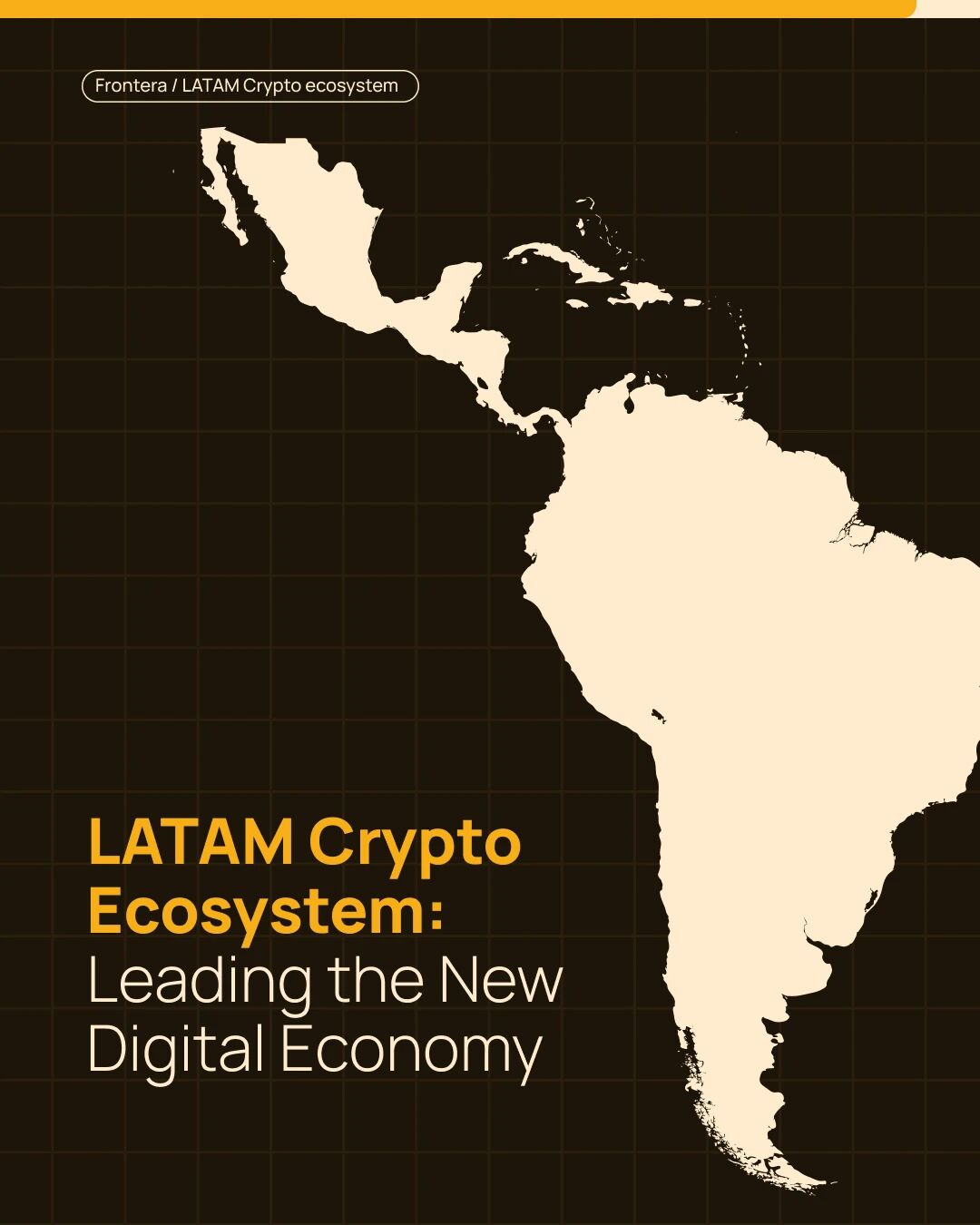
I. The Panoramic View of Latin America's Crypto Ecosystem
1.1 Overall Summary
Over the past 15 years, cryptocurrencies have evolved from a niche toy for liberal geeks to a key component of the global financial landscape, fundamentally changing our understanding and usage of money and value. According to TripleA data, the global population holding virtual assets has increased to 562 million (up from 420 million in 2023), accounting for 6.8% of the world's total population.
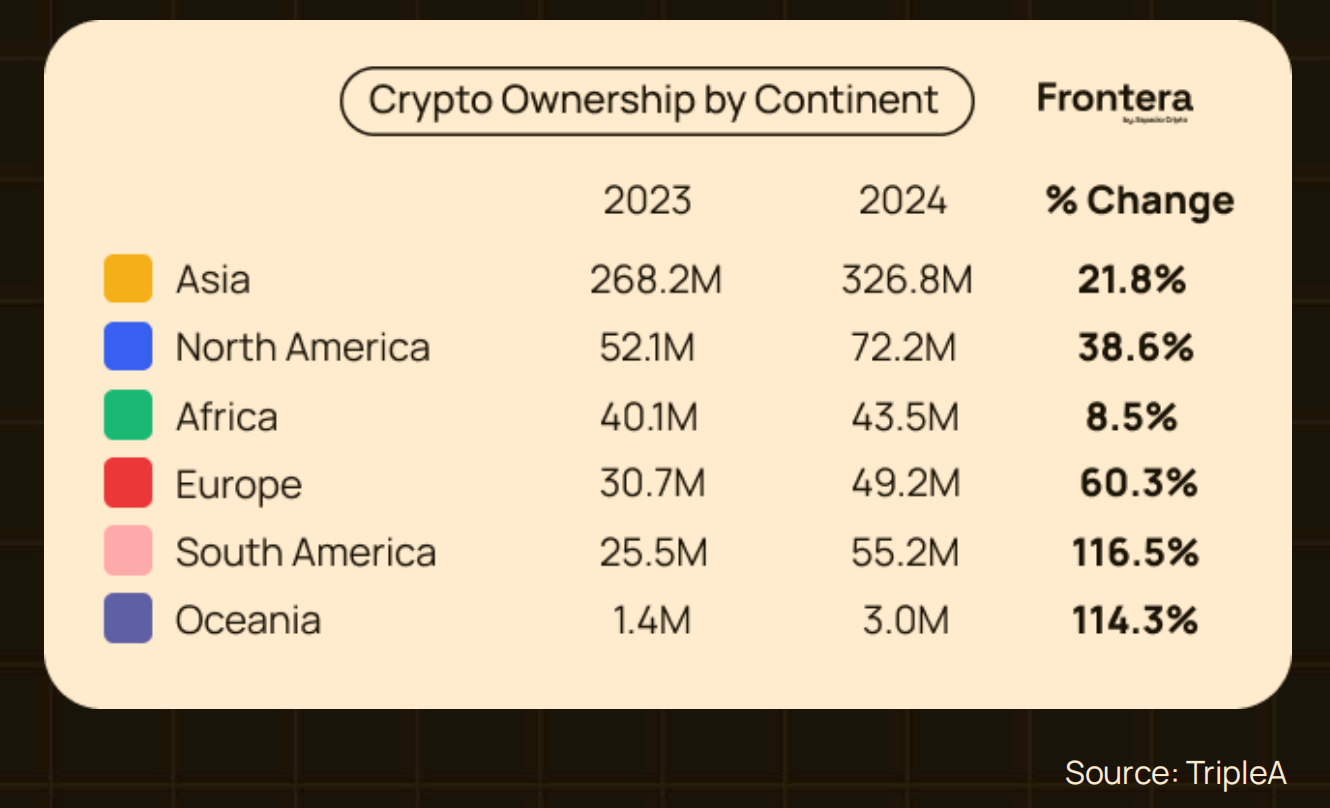
Although more than half of users are still in Asia, South America was the fastest-growing region last year, with the number of users nearly doubling, becoming the third-largest market for crypto adoption globally, surpassing Europe. Within Latin America, Argentina and Brazil lead the way, with both countries serving as dual engines for stablecoin adoption due to different but complementary socio-economic factors.
Argentina's ongoing economic turmoil—years of hyperinflation and strict foreign exchange controls—has forced many citizens to turn to cryptocurrencies like Bitcoin and stablecoins to preserve value. Despite government austerity measures, inflation remains rampant: in October 2024, consumer prices surged 193% year-on-year, the lowest increase of the year (September was 209%), but it marked the sixth consecutive month of slowing. Even so, purchasing power continues to shrink day by day, making cryptocurrencies a lifeline, and the position of stablecoins in Argentina's financial ecosystem is becoming increasingly solid. High internet and mobile device penetration rates provide the technical soil for this process, making it a reliable alternative to traditional finance. Despite economic turmoil, DeFi, tokenization, and payment projects are flourishing.
Brazil, as the most populous and diverse country in Latin America, is seeing a rising rate of crypto adoption driven by a strong interest in the tech sector and a fertile ground for startups/fintech. The national mobile penetration rate ranks among the highest in Latin America, making crypto applications and digital wallets easily accessible; the young, tech-savvy population is highly receptive to new things. Central Bank Digital Currency (CBDC) is on the table, regulatory frameworks are accelerating, and the investment environment is becoming increasingly friendly. Universities and innovation centers are offering blockchain and crypto courses to cultivate local talent. Coupled with Brazil's leading position in Latin America's financial services industry, crypto assets are gradually being integrated into traditional financial products, further accelerating their adoption.
Mexico's crypto adoption is primarily driven by remittance logic. As one of the largest remittance-receiving countries globally, billions of dollars flow back from the U.S. each year, highlighting the high costs and slow speeds of traditional remittance channels, making crypto solutions a faster and cheaper alternative. Compared to Argentina, Mexico's macroeconomic stability means that crypto is viewed more as a convenient tool and investment target rather than an inflation hedge. The fintech sector is strong, driving adoption, but diversity is somewhat lacking, and the ecosystem still needs to mature.
Colombia has a high level of adoption but presents a different picture. Although its economy is not as turbulent as Argentina's, the demand for financial inclusion and the benefits of remittances are driving the growth of the crypto community. Many Colombians work abroad, and remittances account for a significant portion of GDP, making crypto remittances faster and cheaper, thus naturally favored. The government is also gradually introducing regulations, which may pave the way for future adoption.
In summary, the dynamics of the Latin American crypto ecosystem are shaped by the diverse economic, technological, and social factors of each country. Argentina and Brazil remain the dual leaders in adoption, the former due to economic hedging and the latter due to technological dividends; Mexico and Colombia are relatively low-key, focusing on remittances and financial inclusion.
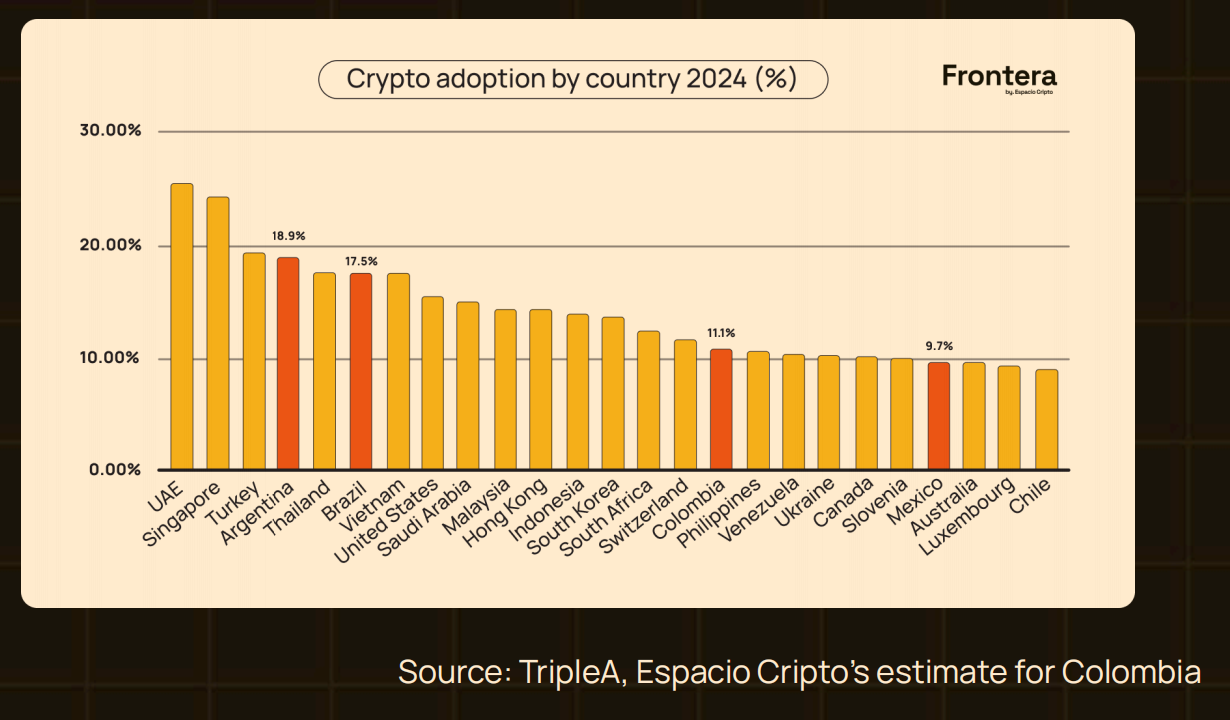
1.2 Latin American Users' Preference for Stablecoins
Before dissecting the current state of the ecosystem, we must return to its origin: the users. Users are the epicenter of this new crypto storm, and any narrative must first address their needs and use cases. Although Bitcoin has been assigned the mission of "hedging against fiat currency devaluation," the vast majority of users in Latin America still choose stablecoins. The latest research from Kaiko shows that over 40% of transactions in Latin America are settled in USDT; in transactions denominated in Brazilian reais (BRL), nearly half are completed using stablecoins.
Due to the difficulty in accurately estimating off-chain crypto transaction volumes, data from the Brazilian government has become key to verifying trends. Since 2019, the Brazilian Federal Revenue Service (Receita Federal) has established a comprehensive reporting system requiring all operating exchanges and large individual users to report monthly. Official data confirms a surge in stablecoin usage: the cumulative trading volume of USDT exceeds 271 billion reais, while Bitcoin's during the same period is 151 billion reais, nearly doubling.
Compared to the global market, stablecoins play a far more central role in Latin America. Using the trading volume of the largest centralized exchange, Binance, as a reference, Bitcoin still dominates globally; however, in Latin America, users' preference for stablecoins reflects regional characteristics—severe fluctuations in local currencies and a lack of confidence, coupled with significant difficulties in obtaining dollars through traditional channels, make "stability" the most scarce financial attribute.
II. Specific Use Cases of Cryptocurrencies in Latin America
The composition of cryptocurrency users in Latin America is diverse, encompassing individuals, businesses, and even government institutions from different socio-economic backgrounds. Understanding this diversity is key to assessing the regional impact of crypto assets.
2.1 Individual Users
A. Economic Hedging
In Argentina, Venezuela, and to a lesser extent Brazil, people use cryptocurrencies as a shield against hyperinflation. With inflation rates in Argentina exceeding 200%, millions of residents have turned to stablecoins like USDC and USDT to save and avoid the devaluation of the peso. For ordinary people, crypto assets represent "digital dollars"—a stable value store that was previously unattainable under capital controls. The Argentine platform Lemon Cash has launched a crypto card, allowing users to spend local currency while settling in crypto assets in the background, and even offering Bitcoin cashback rewards, which has become very popular.
B. Faster and Cheaper Remittances
Remittances are a lifeline for families in countries like El Salvador, Mexico, and Guatemala. Traditional remittance fees are high, and transfers are slow; cryptocurrencies eliminate intermediaries, offering lower fees and faster transfers, which is especially important for low-income families relying on every dollar from overseas relatives. Mexico's leading exchange, Bitso, has captured over 10% of the remittance flow between Mexico and the U.S.
C. Access to Financial Services
A large portion of the population in Latin America—especially in rural areas—lacks banking services or has insufficient access to them. Crypto wallets allow them to save, pay, and even borrow without traditional accounts. DeFi provides a decentralized banking alternative, making it more attractive in areas with weak infrastructure, enabling individuals to take control of their financial futures.
D. Investment and Wealth Growth
In addition to hedging against inflation, some Latin Americans view crypto as an investment target. Digital assets like Bitcoin and Ethereum, with their high volatility, high returns, and low entry barriers, have become part of their wealth growth strategies.
2.2 Businesses and Entrepreneurs
A. Crypto Payments
To avoid high fees and delays from traditional banks, small and medium-sized enterprises in Latin America are beginning to accept payments in Bitcoin and stablecoins. Some merchants in Brazil are using crypto settlements to hedge against local currency fluctuations while connecting with Asian customers who are already familiar with crypto payments, thus expanding their global market.
B. Supply Chain Traceability
The transparency of blockchain is being leveraged across multiple industries. The Costaflores winery in Mendoza, Argentina, has launched the "OpenVino" project, creating one of the world's first open-source wineries: from grape cultivation to bottling, all data is recorded on-chain, allowing consumers to verify authenticity and learn about sustainable practices. The winery has also issued "wine-backed tokens," with each token corresponding to a bottle of physical wine.
C. Freelancers and Gig Workers
The rise of remote work has significantly increased the number of freelancers needing to receive overseas payments. The Argentine platform Takenos has seen a surge in usage, with many freelancers opting to receive payments in Bitcoin or stablecoins to avoid fluctuations in local currency exchange rates.
2.3 Government and Institutional Adoption
A. Blockchain for Government Optimization
In addition to individuals and businesses, some Latin American governments are exploring blockchain to enhance transparency and efficiency. For example, Guatemala is using blockchain to record ballots, creating an immutable election ledger to reduce the risk of fraud.
B. Central Bank Digital Currency (CBDC)
Brazil is at the forefront of the region, piloting the "Digital Real" (DREX) aimed at modernizing the financial system, reducing costs, and improving transaction efficiency, especially for the unbanked population.
The crypto landscape in Latin America is rapidly evolving, with an increasing number of users and use cases highlighting the region's unique needs and challenges. From remittances and daily payments to inflation hedging and government transparency, cryptocurrencies are reshaping Latin America in all dimensions. With the dual drivers of "necessity" and "innovation," Latin America is expected to occupy a leading position in the global crypto market and provide a replicable model for the world.
III. Latin American Crypto Projects, Communities, and Investors
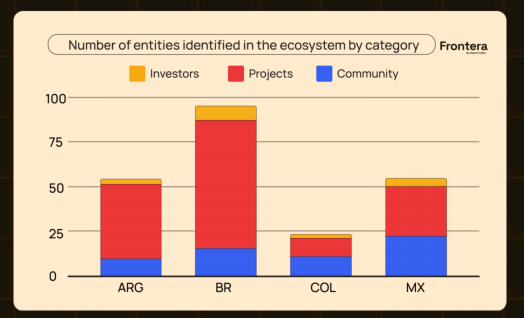
A comparison of four countries shows that the Latin American crypto ecosystem presents a differentiated pattern:
Brazil leads with 71 projects, 15 active communities, and strong institutional interest, featuring a complete and diversified structure.
Argentina (42 projects) has become a breeding ground for innovation due to its economic difficulties, especially in asset tokenization and DeFi; although smaller in scale, it produces solutions that are highly aligned with local needs through resilience and creativity.
Mexico has 21 crypto communities, the highest among the four countries, indicating a rapid increase in adoption, but the number of projects (29) remains relatively low.
Colombia has only 10 projects and 11 communities, still in its infancy, requiring more capital and time to unleash its potential.
Diversity is a core indicator determining the strength and potential of the crypto ecosystem. The more diverse the ecosystem, encompassing a wider range of projects, participants, and technological paths, the stronger its resilience against regulatory, economic, or technological shocks. Diversity fosters continuous innovation, reduces dependence on a single track or major players, and disperses risks, making the system more robust; conversely, a lack of diversity leads to fragility and slow transformation.
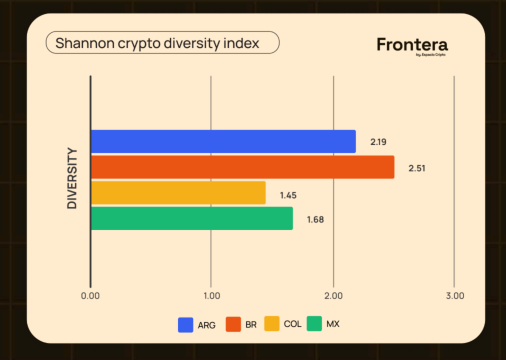
The Shannon diversity index borrowed from biology can quantify this characteristic. This index considers both the "number of categories" and the "number of individuals in each category," with higher values representing greater balance and diversity. The index typically ranges from 1 to 3, with values above 2 considered healthy and evenly distributed.
The calculated results for the crypto ecosystems of the four countries are as follows:
Brazil 2.51 — the highest in the region, with projects, communities, and investors distributed evenly across major categories, demonstrating the strongest resilience.
Argentina 2.19 — good diversity, slightly lower than Brazil, but with a rich and active ecosystem dimension.
Mexico 1.68 — moderate diversity, with some tracks showing high concentration, posing risks of single dependence.
Colombia 1.45 — the lowest diversity, with the ecosystem concentrated in a few areas, still in the early cultivation stage, with the greatest potential for expansion and diversification.
In summary, Brazil and Argentina have formed a balanced and diverse ecosystem, possessing stronger adaptability and risk resistance; Mexico and Colombia have relatively low diversity, facing challenges in future expansion while also holding significant opportunities for improvement.
3.1 Crypto Projects: Developing Products Needed by Users
The uniqueness of Latin American crypto projects lies in "extreme adaptation" and "on-site innovation." They often respond directly to local socio-economic pain points: supply chain opacity, high financing thresholds, inflation eroding savings… Entrepreneurs use blockchain as a "patch" to quickly fill the gaps left by traditional systems—from traceable logistics to compliant DeFi, from community tokens to cross-border payments, with use cases far exceeding the single financial track.
Beyond innovation, "collaboration" and "community" are another lifeline. Developers, investors, and users form a tight-knit network, iterating ideas weekly and upgrading products monthly; when market trends shift, teams pivot overnight. It is this collaboration that allows Latin American projects to maintain rapid evolution amid turmoil.
They also look overseas, actively connecting with international capital and global nodes, using external resources to turn local experiments into scalable business models. Today, many projects have appeared in global roadshow slides, no longer just "Latin American stories," but essential cases in the "global track."
Of course, the regulatory gray rhino is still on the road. As long as regulations remain uncertain, compliance costs hang overhead. However, most teams have learned to "repair the ship while sailing": leaving interfaces ready before regulatory updates and quickly switching when policies are implemented. Ultimately, who can succeed depends on the clarity of each country's regulatory framework. Brazil serves as a model of the benefits brought by "clarity." Clear higher laws and predictable compliance lists have attracted nearly half of the region's projects, with capital and talent continuously flowing south. In contrast, in Mexico, where regulations are volatile or absent, teams spend a lot of energy "guessing policies," forcing innovation to slow down and prematurely welding the ecological ceiling.
In short: Latin American crypto projects, driven by "pain point + community acceleration + global integration," have turned regional disadvantages into experimental advantages; the next step is whether they can transform regulatory uncertainty into institutional dividends, which will determine whether they remain regional stars or become global mainstream players. As the regulatory frameworks of various countries gradually mature, compliant projects will gain greater growth space; and the winners after the end of the "Regulatory Arbitrage" era will undoubtedly be those Latin American native projects that understand global rules while deeply addressing local pain points.
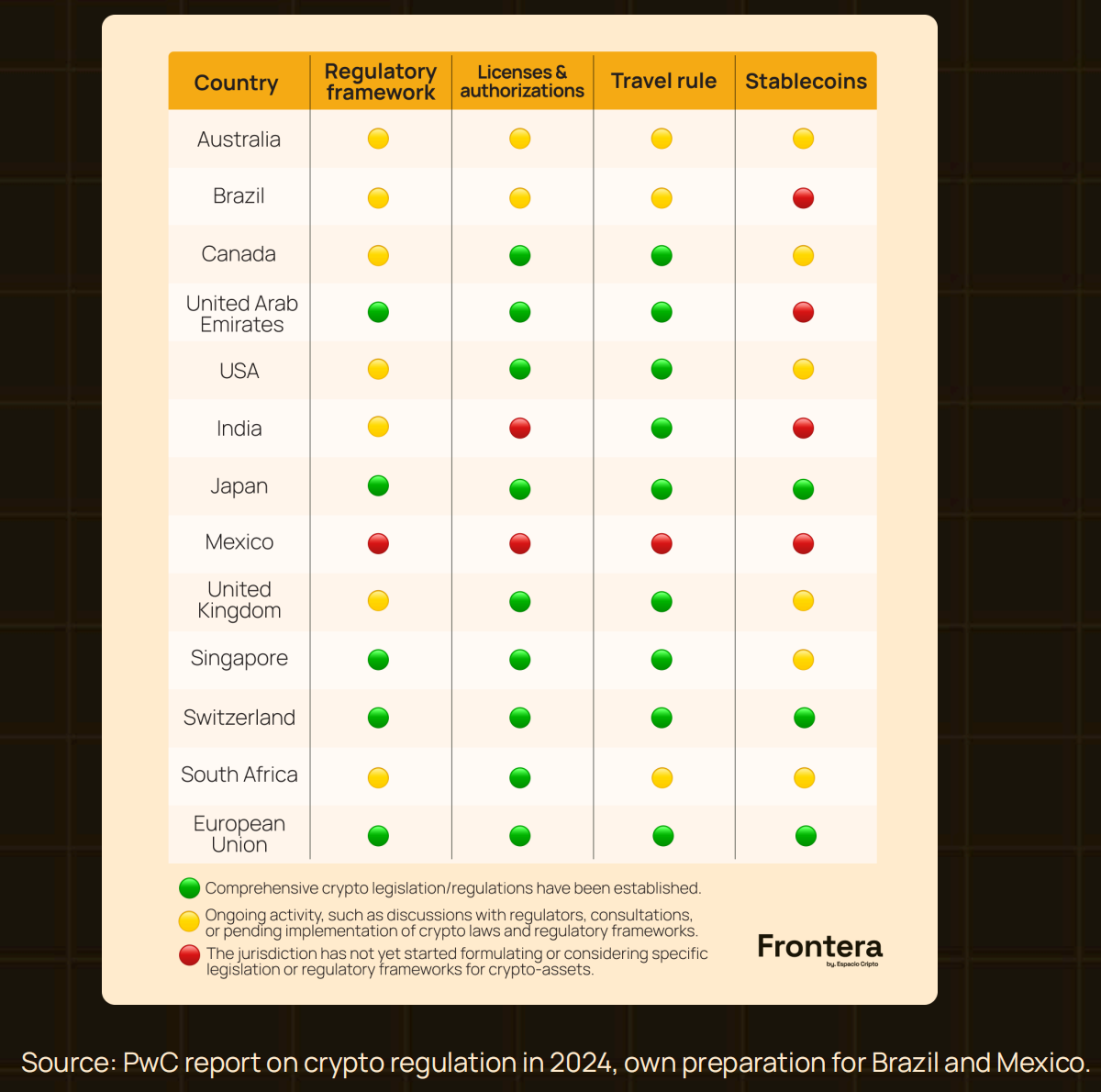
3.2 Community: Injecting Accelerating Pulse into the Ecosystem
The community is at the core of crypto growth in Latin America, playing a fundamental role. They are not just a group of "casual customers" interested in blockchain, but a vibrant ecosystem deeply intertwined with the region's diverse socio-economic fabric. Here, passion and survival needs merge in a wonderful way, creating a unique chemical reaction. Community members include users, developers, entrepreneurs, investors, educators, and enthusiasts, working together to push technology to its limits and drive social change.
The true uniqueness of the Latin American crypto community lies in its starting point: most originate from a group of passionate individuals who firmly believe that "cryptocurrencies can solve local problems," spontaneously gathering from small clusters to ultimately grow into a movement that influences regional discourse. They have not stopped at preaching but have transformed into engines driving adoption across the region. In Latin America, where traditional financial systems are limited or hard to reach, communities act as catalysts: they disseminate knowledge, organize activities, hackathons, and workshops to accelerate blockchain implementation, and even connect emerging companies with potential investors, truly democratizing opportunities. Educators and opinion leaders deliver knowledge for free through YouTube, Twitter, and Telegram, breaking down information that was once behind high walls into digestible "Spanish + Portuguese" versions, achieving knowledge equity.
The "driving factors" vary by country: the core demand of the Argentine community is to escape inflation—crypto is a survival tool rather than a trend; the Brazilian community focuses more on innovation and the implementation of DeFi technology; the narratives of the Mexican and Colombian communities center around remittances and financial inclusion. Buenos Aires, São Paulo, Mexico City, and Bogotá have become regional hubs, regularly hosting meetups, conferences, and hackathons to promote networking and collaboration.
What truly keeps the community sticky is "usage" rather than "speculation." In Mexico and El Salvador, remittances are the lifeline of family economies; cryptocurrencies have reduced cross-border transfers from "days" to "minutes," cutting fees to a fraction of traditional channels. In remote areas where banks have not reached, communities not only promote digital assets but also use them as tools to bridge the last mile of financial inclusion.
Collaboration is another underlying theme. These communities not only delve deep into their own countries but also actively connect with global projects, bringing new technologies, capital, and knowledge into Latin America; at the same time, cross-border interactions within the region are frequent, with Argentine developers, Mexican entrepreneurs, and Colombian designers co-writing code and launching tokens, forming a "borderless" innovation belt that makes the local ecosystem more resilient through interconnectedness.
Social impact is also significant. In regions with huge gaps in traditional finance, cryptocurrencies are seen as empowerment tools: saving, investing, and paying can all bypass banks. Numerous community projects use on-chain transparency for charitable donations and support local small businesses with crypto payments, ensuring that "technological dividends" directly reach corner grocery stores and rural schools.
Conferences and hackathons serve as "offline refueling stations" for the community. Established summits like LABITCONF (Latin American Bitcoin and Blockchain Conference) attract global developers, funds, and regulators each year, bringing Latin America from the margins into the mainstream agenda; monthly meetups and hackathons in various countries continue to incubate new teams and use cases, keeping the innovation cycle at a high speed.
Of course, behind the enthusiasm lies a shadow. Regulatory uncertainty is the biggest roadblock—policies vary from country to country, and community initiatives are often interrupted by suddenly changing regulations. However, in countries like Argentina and Venezuela, where hyperinflation prevails, economic collapse has instead become the best demonstration ground: communities use the vivid example of "immediately converting today's salary into USDT" to turn crises into public lessons on crypto practicality, showcasing their resilience.
Ultimately, the Latin American crypto community is deeply embedded in the local socio-economic fabric. They are not just clubs of enthusiasts but also the movers of technology implementation, the fixers of financial gaps, and the engines of regional innovation. As the community continues to expand, they will play a more significant role in the next chapter of the global crypto industry.
3.3 Investors: Injecting Capital for the Future
Venture capital (VC) and various funds are decisively shaping the evolution of the crypto ecosystem, providing funding for the most innovative and disruptive startups. These investors not only inject capital into early-stage projects but also help them expand operations with strategic experience and key resources. They are collectively focusing on Latin America: unique economic pain points, rapid penetration of crypto and blockchain, along with innovative solutions proposed by local startups, form the rationale for "betting." In recent years, top global institutions like a16z, SoftBank, and Sequoia have heavily invested in local crypto projects, betting that they can not only disrupt traditional finance but also rewrite the rules of other pillar industries.
Local funds are also indispensable. Early players like Kaszek Ventures and Monashees continue to provide "blood transfusions" to seed rounds, helping teams turn prototypes into products that can expand across regions. However, after the explosive growth of 2021, with global interest rates rising and liquidity tightening, 2023 has seen Latin American VC enter a consolidation phase. While the total investment remains on par with pre-pandemic levels, it has significantly dropped from the peak in 2021, with institutions becoming increasingly selective—only investing in "hard" projects with clear paths to profitability that can generate cash flow during subsequent financing freezes.
This rhythm aligns with global trends: the total amount of VC worldwide peaked in 2021 and has declined for two consecutive years, with 2023 falling to less than half of 2021, only matching 2020 levels. However, Latin America has seen a more severe decline, with investment in 2023 amounting to only 25% of that in 2021. The reasons include a smaller market size and greater sensitivity to global macro fluctuations. Nevertheless, capital continues to flow in, albeit more cautiously; sectors like fintech and e-commerce show resilience, proving that Latin America still holds appeal for risk capital.
As the global VC market gradually stabilizes, Latin America is expected to welcome a new wave of funding, especially for projects that address social and economic pain points, have solid compliance, and possess scalable business models. In a more selective capital environment, only teams with the strongest value propositions, the lowest regulatory risks, and the most resilient business models will secure tickets to the next round.
Finally, we have observed a number of traditional companies integrating cryptocurrencies and blockchain technology into their operations, marking an important step in digital transformation. This category includes mature institutions such as banks and e-commerce platforms that have incorporated crypto services into their existing businesses to meet market demands for more agile and decentralized solutions. For example:
Banks are launching crypto asset custody services, allowing customers to securely store and manage digital assets;
E-commerce platforms are directly opening up cryptocurrency purchasing, custody, and selling functions, achieving a "one-stop" crypto experience.
IV. Cryptocurrency Adoption in Latin American Countries
4.1 Argentina
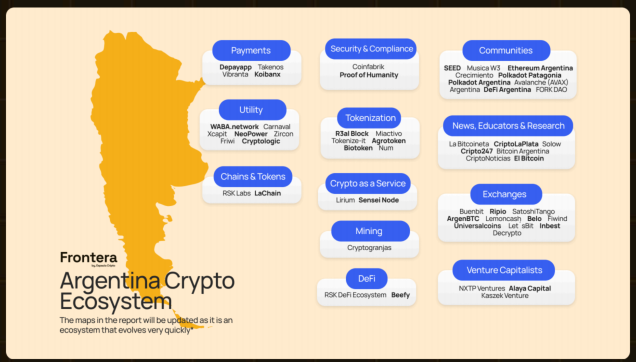
Argentina has become the "epicenter" of cryptocurrency adoption in Latin America, and this is no coincidence. Multiple economic factors, such as hyperinflation, the continuous devaluation of the peso, and the collapse of trust in the traditional financial system, have forced millions of Argentinians to view digital assets as a safe haven. In this context, cryptocurrencies are not only investment tools but also means of preserving value amid extreme volatility. Meanwhile, the local crypto community is thriving, providing fertile ground for the innovation and implementation of decentralized solutions. This diverse and rapidly expanding ecosystem consists of active communities, innovative projects, and bold investors, facing numerous challenges but also containing immense opportunities.
Why choose Argentina? As the undisputed leader in crypto adoption, Argentina has a population that is only one-fifth that of Brazil, yet it boasts the highest trading volume in the region. With a mature market, the largest active user base available for real-time testing, and a globally influential group of blockchain application developers, the country has tremendous entrepreneurial potential. Now is the time to leverage this momentum, positioning Argentina as a hub for blockchain technology and innovation, producing internationally competitive products and further solidifying its leadership in the crypto ecosystem.
A. Community
The growth of the crypto community is the most iconic driving force behind Argentina's ecosystem. They not only promote education but also build collaborative networks for exchanging ideas and launching disruptive projects. The most influential groups include:
Crecimiento: By focusing on education and co-creation spaces, it has become a hub connecting innovators and blockchain enthusiasts nationwide. Recent large-scale events have attracted industry leaders and facilitated connections between startups and investors.
Ethereum Argentina: A local branch of the global Ethereum network, promoting the adoption of smart contracts and DApps through hackathons and events.
Polkadot Patagonia & Polkadot Argentina: Focused on promoting the Polkadot ecosystem, organizing interoperability and parachain development activities to strengthen the country's technological infrastructure.
FORK DAO: An emerging DeFi community dedicated to developing decentralized applications, positioning DeFi as a viable alternative to traditional finance.
B. Projects
The project landscape in Argentina is extremely diverse, ranging from established exchanges to asset tokenization and DeFi platforms, reflecting the vitality of local entrepreneurs adapting blockchain to various industries.
Exchanges
Ripio: A "veteran" in Argentine crypto, offering not only trading but also lending and crypto credit cards, bringing digital assets into everyday consumption.
Lemon Cash: Quickly gained popularity with "BTC back on every purchase," bringing crypto payments into households.
Asset Tokenization
Agrotoken: Tokenizes agricultural products like soybeans, corn, and wheat, allowing farmers to finance or liquidate using tokens, creating new pathways for agricultural finance.
R3al Block: Focused on real estate tokenization, enabling high-value properties to be traded in fractions, enhancing liquidity and lowering investment thresholds.
Financial Solutions and DeFi
RSK Labs: Implements smart contracts on Bitcoin, covering lending, stablecoins, and more, contributing to financial inclusion.
Beefy: A yield aggregator that helps users achieve higher returns in DeFi through automated strategies, becoming a new alternative to traditional investments.
Infrastructure
Coinfabrik: Provides blockchain development, security audits, and platform building, serving as the "construction and security team" of the local ecosystem.
Sensei Node: Operates blockchain nodes to enhance network decentralization and security.
C. Investors
Despite the complex economic environment, both local and international funds still view Argentina as fertile ground for technological innovation.
Alaya Capital: Bets on crypto infrastructure and DeFi startups, aiding the evolution of the financial system towards greater inclusivity and resilience.
Kaszek Ventures: One of the largest VCs in Latin America, focusing on fintech and crypto products, driving regional ecosystem expansion.
NXTP Ventures: Deeply engaged in Latin American tech startups, having invested in several companies using blockchain to address local pain points, helping projects scale and transform the financial industry.
D. Challenges for Traditional Companies
Regulatory and economic uncertainties make it difficult for traditional enterprises to operate. One of the largest private banks, Banco Galicia, attempted to launch crypto services but was forced to halt under direct intervention from the central bank, highlighting the lack of a regulatory framework and authorities' hesitance regarding financial institutions' involvement in crypto.
E. Regulatory Dynamics in Argentina
2024 Regulatory Landscape
2024 is a pivotal year for the regulatory framework of Argentina's crypto asset industry. In March, Law No. 27,739 came into effect, amending Law No. 25,246 (which prevents money laundering, terrorist financing, and the proliferation of weapons of mass destruction). The new law formally defines "virtual assets" for the first time at the legal level and establishes a national registry for "Virtual Asset Service Providers (VASP)" regulated by the Argentine National Securities Commission (CNV), allowing them to operate in compliance with anti-money laundering/anti-terrorist financing frameworks. At the same time, VASPs are incorporated into the national anti-money laundering and anti-terrorist financing system, under the supervision of the Financial Intelligence Unit (UIF).
This institutional shift paves the way for a series of regulatory measures and opens doors for the implementation of crypto and blockchain technology in traditional scenarios, bringing the following milestones:
Establishing companies with crypto assets as capital contributions. According to Law No. 27,739, VASPs play a key role in Argentina's anti-money laundering system, explicitly allowing the use of virtual assets (VAs) as paid-in capital, designating VASPs as "crypto equity" verification institutions. Key points: Bitcoin and USDC are officially recognized by IGJ as legitimate capital contribution tools for registering companies in Argentina; transparent valuation: the number of shares is calculated based on the market price of the crypto asset against the peso on the day of contribution.
For the first time, Argentina includes crypto assets in tax amnesty. Law No. 27,743, passed on July 8, 2024, explicitly classifies cryptocurrencies as taxable assets that must be declared, becoming part of a one-time tax regulation and asset externalization system. This system allows Argentine citizens to "cleanse" undeclared assets up to $100,000: amounts exceeding this limit can be declared compliant by paying a one-time tax at a preferential rate within a specified period. Participation conditions include: the relevant cryptocurrencies must be stored on exchanges registered as VASPs with the CNV and a formal declaration must be submitted. The new system led to a historic high in crypto asset recharge volumes in September 2024, with Bitcoin recharge amounts reaching three times the average monthly level for the year.
Bitcoin and Ethereum ETFs' CEDEAR. The CNV's Resolution No. 1030/2024 paves the way for the issuance of Argentine Depositary Receipts (CEDEAR) linked to Bitcoin and Ethereum ETFs in the Argentine capital market. Investors can gain exposure to cryptocurrency prices through CEDEAR without directly holding crypto assets. Like underlying ETFs, these CEDEAR must be purchased through brokers authorized by the CNV and do not involve actual custody or direct usage rights of the underlying assets.
2025 Regulatory Outlook
As the crypto ecosystem becomes increasingly intertwined with traditional sectors such as capital markets and banking systems, there is an urgent need for regulatory rules aimed at promoting this integration and encouraging broader adoption and usage; any excessive regulation of virtual assets or their service providers is unnecessary. To achieve this integration, the following aspects should be prioritized:
Tax treatment of virtual assets. Due to the lack of up-to-date measures (for example, it remains unclear whether virtual assets will be included in the scope of bank lending taxes), Argentina faces numerous challenges regarding the tax treatment of virtual assets. Law No. 27,743 has taken a step in the right direction by including these assets in asset regulations and externalization systems for the first time, but inequalities compared to other investment tools still persist.
Tokenization of real-world assets. The tokenization of stocks, financial assets, and real estate requires updates at the regulatory level to leverage the efficiency and security brought by blockchain, enabling the issuance, trading, and verification of ownership in digital form. This process has already begun in several countries, allowing people to access investment opportunities more agilely, securely, and efficiently. To promote this issue, the Argentine Fintech Chamber has drafted a reform proposal advocating for the differentiation of tokenized assets from traditional regulatory frameworks. The document emphasizes that blockchain can provide protections comparable to traditional mechanisms through features such as distributed ledgers, verifiability, transparency, and immutability; it also points out the potential use of smart contracts governed by autonomous rules, including lock-up/vesting clauses and automatic dividends. This approach will bring benefits such as increased liquidity, asset fragmentation, reduced intermediary costs, and true democratization of investment access.
Building national strategic reserves with Bitcoin or virtual assets. Another key development this year is the submission of a draft proposal allowing the Argentine Central Bank (BCRA) to purchase, store, and mine Bitcoin, suggesting that part of the central bank's reserves be allocated to this cryptocurrency. Currently, the BCRA's charter does not explicitly address cryptocurrency mining; regarding the purchase of crypto assets, existing regulations allow for the trading of "financial assets," but it is unclear whether this definition includes cryptocurrencies.
Buenos Aires Crypto Economic Special Zone. In 2024, Argentina further solidified its status as the crypto capital of Latin America, attracting hundreds of startups, companies, and global developers to the Aleph Technology Center in Buenos Aires, known as the "City of Growth" (Ciudad de Crecimiento). The pathway to achieving this goal is to establish a comprehensive set of tailored regulatory frameworks covering specialized tax, labor, and social security systems, while also providing infrastructure incentives, legal certainty, and investment incentives for this inherently borderless technology.
F. Challenges and Opportunities
With Javier Milei taking office, Argentina's crypto ecosystem stands at a "crossroads." Milei has openly supported cryptocurrencies and proposed a legalization plan that allows taxpayers to declare crypto assets without additional proof. If he advances a bold and progressive regulatory framework, it could protect consumers and position Argentina as a leader in the region. However, macro indicators remain highly volatile, and economic instability keeps investors cautious. Once policies successfully mitigate risks, capital confidence and inflows are expected to rebound quickly. The strong demand for DeFi and asset tokenization, combined with Argentina's inherent entrepreneurial spirit, may give rise to a new wave of market disruptors.
G. Future Outlook
During Milei's tenure, Argentina's crypto prospects will be as thrilling as a roller coaster. If regulations become clearer and more friendly, international capital may flock in, solidifying its status as the "crypto capital of Latin America." Once it overcomes both regulatory and macroeconomic challenges, Argentina is poised to occupy a key position in the global crypto landscape, becoming a trendsetter and focal point in the Spanish-speaking world.
4.2 Brazil
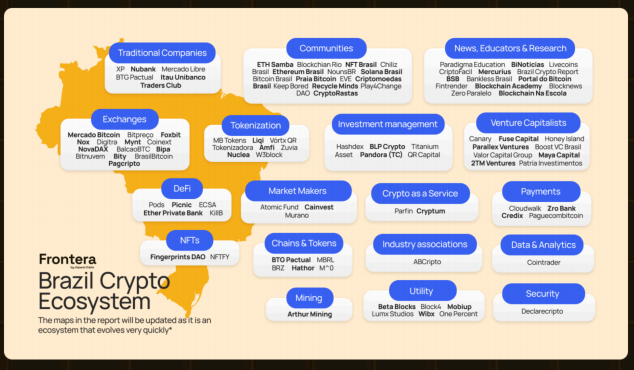
Blockchain is permeating every corner of Brazil at an astonishing pace—from the beaches of Rio de Janeiro to the most digitized favelas, cryptocurrencies are everywhere. Economic factors such as inflation and financial exclusion have driven this "silent revolution": what was once a niche path has now become an unstoppable wave embraced by the masses.
The key driver behind this is Brazil's crypto regulatory framework. Enacted in December 2022 and officially effective in June 2023, it is a milestone in Latin America: the Central Bank of Brazil (BCB) is authorized to regulate virtual asset service providers, while token projects classified as securities are overseen by the Securities and Exchange Commission (CVM). The new regulations not only protect consumers but also set a benchmark for the region, potentially accelerating neighboring countries to establish their own regulatory frameworks.
A. Community
The Brazilian crypto community is like a continuously roaring engine, fueled by passion and a desire to change the status quo.
Blockchain Rio: An annual conference that brings together developers, businesses, and enthusiasts, it is the most important on-chain "social magnet" in Latin America.
Ethereum Brasil: Injects continuous momentum into smart contract and DApp development through hackathons and large-scale events.
Praia Bitcoin: Brings Bitcoin lectures to the beach, making crypto truly "sunbathe" in daily life.
Other active local nodes: Ecosystems like Polygon, Solana, and Polkadot also have Portuguese-speaking communities, creating a "samba rhythm" of multi-chain progress.
B. Projects
Brazil is a fertile ground for crypto entrepreneurship, where creativity and boldness thrive.
Exchanges
Mercado Bitcoin: The largest in the country and a benchmark in Latin America, it was the first to enable asset tokenization and raised $200 million in Series B funding from SoftBank in 2021.
Mynt (BTG Pactual): A retail entry directly from a traditional investment banking giant.
Asset Tokenization
Liqi: A startup that "fragments" real estate, equity, and agriculture onto the blockchain, allowing high-threshold assets to be tokenized for as little as 100 reais.
Amfi: A compliant token issuance platform that has successfully launched cases for hotel revenue rights, private equity, and more.
Stablecoins
- M^0 (M-Zero): A "decentralized crypto dollar" with a multi-issuer model, allowing qualified collateral to mint coins, reducing single-point risks, aiming to become the "on-chain Federal Reserve" for emerging markets.
Financial Solutions and DeFi
Hashdex: One of the first crypto ETF manufacturers, BITH11 (Bitcoin ETF) and HASH11 (Metaverse ETF) have brought 300,000 traditional investors into crypto.
Picnic: A one-stop DeFi entry point that aggregates yield, staking, and insurance, with an interface akin to "Brazil's version of Alipay."
Infrastructure
Parfin: Crypto-as-a-Service, providing custody, liquidity, and matching APIs for banks and brokers, with clients including Itaú and BTG.
Cointrader Monitor: A real-time price, depth, and arbitrage radar, an essential "market tool" for local traders.
Atomic Fund: A market maker ensuring depth for local exchanges like Mercado Bitcoin and Foxbit.
Arthur Mining: A hydroelectric and solar mining facility with a PUE of 1.05, fully embracing ESG narratives.
C. Investors
Canary: A $200 million early-stage fund that has invested in Hashdex, Liqi, and Picnic.
Monashees: A veteran VC in Latin America, heavily invested in DeFi and blockchain infrastructure.
Valor Capital Group: Focused on cross-border fintech, bringing "long money" from U.S. LPs into Brazil's on-chain world.
D. Traditional Enterprises Entering the Market
Brazilian traditional enterprises are actively embracing cryptocurrencies due to both strategic considerations and market-driven factors, making them stand out in the region. On one hand, crypto assets provide a hedge against the continuous devaluation of the real, enriching investment options; on the other hand, despite the regulatory framework still being refined, Brazil's open attitude towards financial innovation has significantly reduced compliance risks for businesses. This relaxed environment allows traditional companies to expand services, attract tech-savvy new customers, and seize opportunities in digital competition. Coupled with Brazil's business culture that values innovation and rapid experimentation, the integration of cryptocurrencies is not only feasible but also seen as a strategic necessity for enhancing competitiveness.
Typical examples of this trend include:
XP Investimentos: As one of Brazil's largest brokerages, XP has launched cryptocurrency-related services, showcasing the integration of crypto assets by traditional financial institutions.
Nubank: Brazil's largest digital bank has introduced cryptocurrency trading features, marking the formal integration of crypto services into the traditional banking system.
Mercado Libre: This Latin American e-commerce giant has integrated cryptocurrency features into its payment platform, allowing tens of millions of users to easily access the crypto world.
BTG Pactual: One of Brazil's top investment banks, it has launched exchanges, crypto investment funds, and other products, highlighting its significant position in the local market.
E. Challenges and Opportunities
One of the biggest challenges facing Brazil's crypto ecosystem is the final implementation of the regulatory framework and tax details—if policies are too stringent, they may stifle businesses and dampen capital enthusiasm. However, this also presents a "turning crisis into opportunity" window: Brazil is expected to create a mature regulatory framework that encourages innovation while protecting consumers. The most noteworthy initiative is the Central Bank Digital Currency (CBDC) project DREX. If successfully launched, it will inject new momentum into the Brazilian economy by lowering transaction costs, enhancing financial inclusion, and improving system efficiency; it will also position Brazil as the first in Latin America to have a benchmark CBDC, providing a replicable "Brazilian template" for neighboring countries.
F. Future Outlook
Brazil possesses all the elements to become a global crypto hub: a vibrant community, a plethora of innovative projects, and an open and progressive regulatory framework are collectively driving the country to lead the next wave of financial transformation in Latin America. Local cases like Liqi and M^0 not only demonstrate Brazil's ability to embrace emerging technologies but also prove that its innovations can resonate globally. As regulations are implemented and projects mature, Brazil is poised to take center stage in the evolution of decentralized finance, reshaping not only its own economy but also profoundly impacting the global crypto landscape.
4.3 Colombia
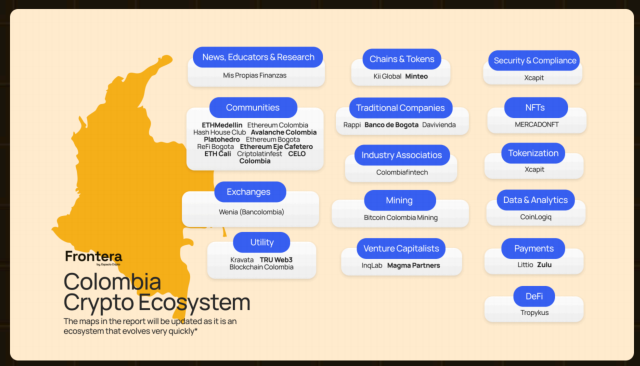
With a vibrant atmosphere of technological innovation, Colombia is beginning to carve out its own path in the crypto world. Despite facing economic and regulatory challenges, creativity continues to drive the growing crypto ecosystem. However, the lack of regulatory clarity and regional technological gaps limit its potential to become a true crypto hub in the short term. Fortunately, the active communities, innovative projects, and increasing investor interest in cities like Bogotá and Medellín are helping Colombia secure a place in the Latin American cryptocurrency landscape.
A. Community
The crypto community is the heart of Colombia's ecosystem, dedicated to education, collaboration, and innovation. The most influential players include:
ETH Medellín: The most active Ethereum community in the country, based in the "City of Innovation," Medellín, regularly hosts hackathons and workshops to promote smart contract and DApp development.
Celo Colombia: Focused on financial inclusion, promoting the Celo blockchain on mobile platforms, opening the door to cryptocurrencies for groups underserved by traditional banks.
B. Projects
Colombia has seen the emergence of several projects aimed at using blockchain to solve local and global issues, with scalable solutions covering various tracks from financial inclusion to DeFi adoption:
Littio: Focused on "digital dollar" savings and payments, connecting with local merchants, and has become an entry tool for everyday crypto consumption due to its low barriers to use.
Wenia (under Bancolombia): A traditional bank directly entering the market, allowing users to buy and sell cryptocurrencies with one click within the bank's app, breaking down the final barrier between fiat and digital assets.
Tropykus: A DeFi platform focused on emerging markets, providing decentralized lending and interest-earning options, offering viable alternatives for the unbanked population.
Kravata: An infrastructure service provider dedicated to simplifying Web3 technology, based in Colombia. The company offers API-based compliant digital asset access services through its "Crypto-as-a-Service" (CaaS) solution, supporting secure, low-cost, and efficient two-way exchanges between local fiat and crypto assets. Its technical architecture helps individuals and businesses in Latin America fully unleash the potential of decentralized finance (DeFi) and Web3. In its first year of operation, Kravata processed $215 million. In March 2024, it received support from international capital such as Volt Capital, Framework Ventures, and Circle Ventures, aiming to address the transaction infrastructure challenges in Latin America through blockchain technology.
C. Investors
Several venture capital firms have been attracted by the potential of Colombia's crypto ecosystem:
InQLab: Focuses on local blockchain startups, promoting ecosystem growth through strategic investments.
Magma Partners: A Latin American fund betting on fintech innovation in Colombia, helping local crypto companies accelerate their development.
D. Traditional Enterprises Entering the Market
Local giants in Colombia are also starting to experiment with "on-chain" initiatives:
Rappi: The delivery platform has begun testing crypto payments, allowing users to place orders directly with digital assets, showcasing the seamless integration of traditional services and crypto.
Banco de Bogotá: The first to participate in the central bank's sandbox, piloting direct crypto deposits and withdrawals for bank accounts.
Davivienda: Actively exploring the integration of crypto assets into its existing product lines to meet the growing demand for innovative financial solutions.
E. Challenges and Opportunities
Colombia's crypto ecosystem faces multiple constraints to becoming a regional hub. The primary obstacle is regulatory ambiguity: Although the government has repeatedly stated its intention to legislate, progress has been slow and inconsistent, causing investors and startups to hesitate in making significant bets. The lack of clear rules to protect consumers and define corporate responsibilities directly stifles market expansion. Additionally, there is a significant technological gap—while cities like Bogotá and Medellín have advanced infrastructure, remote areas suffer from weak networks, leaving rural populations, who most need alternative financial services, on the sidelines.
However, the opportunities are equally vast. Colombia ranks high in remittance volume in Latin America, and crypto remittances can significantly reduce costs and increase efficiency; a large unbanked population provides fertile ground for crypto adoption. The trial efforts of traditional financial institutions also send positive signals: banks like Bancolombia and Davivienda have initiated crypto sandboxes, and if regulatory direction becomes clearer, access to mainstream financial channels will rapidly expand the user base. The key lies in whether the government can find a balance between "encouraging innovation" and "protecting consumers" to implement clear and friendly policies.
F. Future Outlook
Colombia's ability to secure a place in the Latin American crypto landscape depends on the pace of regulatory and digital infrastructure evolution. If transparent regulations can be established and rural network gaps addressed, Colombia is likely to leverage remittances and inclusive finance to achieve a leap forward, becoming a player that cannot be ignored in the region; conversely, it may continue to observe from the sidelines as a "potential market." The outcome remains to be seen, pending government action.
4.4 Mexico
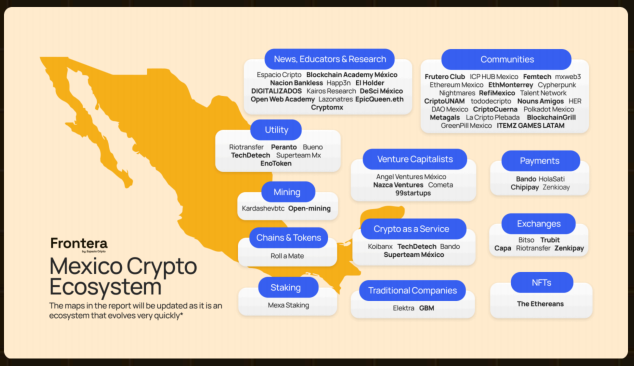
Mexico is emerging as a key player in the Latin American crypto landscape. With a large population and regional economic influence, the country has significantly accelerated crypto adoption and blockchain innovation; the leap in fintech, vibrant entrepreneurial culture, and increasing acceptance collectively make Mexico a fertile ground for crypto development.
A. Community
The Mexican crypto community is the backbone of the entire ecosystem, providing collaboration, education, and networking opportunities. Through events, hackathons, and workshops, they not only impart knowledge but also stimulate innovation. The most prominent groups include:
ETH Mexico: Focused on Ethereum and decentralized applications, hosting large hackathons and summits that bring together developers, investors, and enthusiasts to promote local project growth.
Frutero Club: Emphasizes social interaction and education, lowering the cognitive barriers to crypto understanding in relaxed settings, allowing newcomers to learn how to use wallets through conversation.
H.E.R. DAO Mexico: Dedicated to increasing female participation in the crypto space, forming teams for projects through internal hackathons and workshops, and sending outstanding results to larger platforms.
B. Projects
Mexico also boasts a number of platforms and solutions that are reshaping the digital economy:
Bitso, the leading cryptocurrency exchange platform in Latin America, was founded in 2014 and is headquartered in Mexico, operating in eight countries including Mexico, Argentina, Brazil, Chile, and Colombia, often referred to as the "Coinbase of Latin America." By 2025, it is expected to have over 9 million users, serving both individual and corporate clients, and is the first crypto unicorn in Latin America (valued at $2.2 billion). The company's mission is to promote financial inclusion through blockchain technology and build a borderless financial ecosystem.
Supports trading of over 100 cryptocurrencies for consumers, with fiat currencies MXN, BRL, ARS, and USD available for instant deposits and withdrawals via SPEI/PIX/ACH.
Bitso Business serves 1,900 companies with stablecoin payments, bulk payroll, and API settlements, allowing access to Latin America without local licenses; its flagship product, Bitso Transfer, uses the Ripple network and stablecoins for cross-border remittances, with instant arrivals and fees 50% lower than SWIFT.
Launched the MXN stablecoin and BRL1 stablecoin to address local currency exchange issues.
Supports cryptocurrency payments through the Pay with Bitso system, integrating with offline POS machines, e-commerce platforms, digital entertainment platforms, subscription companies, etc.
In 2021, it raised $250 million in Series C funding from Tiger Global, Coatue, Paradigm, etc., with a valuation of $2.2 billion. It holds dual regulatory licenses from Gibraltar and Mexico, with a team of 500 spread across 35 countries, serving as both an entry point for retail investors and the infrastructure for multinational companies to facilitate stablecoin payments in Latin America.
Bando: An emerging protocol focused on on-chain payments, using decentralized finance solutions to lower the entry barriers for the public.
The Ethereans: An NFT art team that issues limited digital collectibles on Ethereum, attracting attention from both the art and tech circles.
Kardashevbtc: A large mining enterprise focused on sustainability and energy efficiency, building a green computing power base in Mexico.
C. Investors
With the surge in demand for fintech and blockchain, both local and international venture capital firms are betting on Mexico:
Angel Ventures Mexico: Focuses on high-growth tech/fintech startups, actively investing in the crypto space to help companies seize opportunities in the digital market.
Cometa: Adheres to a long-term perspective, investing in crypto teams that build the next generation of financial infrastructure, promoting national-level financial infrastructure upgrades.
D. Challenges and Opportunities
Despite rapid growth, Mexico still faces significant challenges. The lack of regulatory clarity is the biggest obstacle: while it appears more lenient than neighboring countries, policy uncertainty still leaves entrepreneurs and investors indecisive. Authorities' cautious "wait-and-see" attitude towards crypto assets has deterred traditional institutions from entering the market, slowing down innovation and weakening the willingness of international players to establish a presence. Additionally, institutional investors' high demands for risk premiums continue to limit the capital pipeline for new projects.
However, the opportunities are equally vast. The booming digital economy, favorable demographics, and vibrant fintech ecosystem lay fertile ground for crypto adoption. The traditional payment and remittance systems fail to cover all populations, creating a huge demand for alternatives—remittances being the top scenario. Currently, Mexico's crypto penetration rate lags behind Argentina and Brazil, while its total economic output ranks second in the region, indicating that once policies become clear, growth potential could be exponentially released.
F. Future Outlook
Although there is still a long way to go before becoming a "regional crypto hub," Mexico's prospects remain bright. If it can establish a clear and friendly regulatory framework, it will attract more investors and projects, gradually solidifying its key position in the Latin American crypto ecosystem; given time, it may lead the wave of cryptocurrency adoption and innovation across the region.
However, the real obstacles cannot be ignored: high market volatility, policy uncertainty, and insufficient digital skills among parts of the population are hurdles that Mexico must overcome. Whether it can effectively address these challenges will determine if the country can ultimately become a center for crypto innovation in Latin America.
4.5 Peru
Peru ranks seventh among the countries with the highest acceptance of crypto assets in Latin America and is the third fastest-growing crypto market in the region. With regulatory progress, technological integration, and increasing public interest in digital assets like Bitcoin, Peru has firmly established itself as one of the most promising markets in the Americas. Key milestones include:
Interoperability under regulation: Under the leadership of the Central Reserve Bank of Peru (BCRP) and the Electronic Clearing House (CCE), local and foreign fintech companies (including Lemon) have been able to connect with the Peruvian financial system.
Increased fintech penetration: The number of fintech companies is expected to grow by 20% in 2024 compared to 2023, increasing from 288 to 346.
By mid-2024, the market is expected to experience explosive adoption, with the number of crypto application downloads doubling compared to the first half of the year, leading to a wave of new users entering the market for crypto asset trading.
A. Reasons for Increased Adoption
What has driven this sudden surge in adoption? It was the approval of "interoperability" in September 2024. Since that moment, Peru has seen explosive growth in both the number of transactions and the participation of local and foreign institutions. This includes dual-currency wallets like Lemon, which allow the sol and digital currencies to coexist. With the implementation of interoperability, Lemon has presented an unprecedented value proposition to the Peruvian market:
This development not only simplifies the entry barriers for crypto assets but also reveals the enormous latent demand for crypto assets among the Peruvian population. Previously, this market was almost monopolized by experienced players, most of whom traded through P2P (peer-to-peer) platforms. The arrival of interoperability has cleared the adoption barriers, allowing many Peruvians who missed the opportunity to buy during Bitcoin's historical peak in March 2024 to re-enter the market during subsequent high points that year.
At Lemon, this surge of enthusiasm was confirmed when Bitcoin broke the $100,000 mark in December 2024: the number of independent users and Bitcoin purchases both reached peak levels for the platform in Peru that month. Another key phenomenon shaping Peru's crypto ecosystem in 2024 is the rise of Worldcoin (WLD).
This project primarily attracts tech enthusiasts and highlights the market's significant demand for "user-friendly tools"—tools that can seamlessly integrate crypto assets into everyday financial activities.
Its popularity is such that in 2024, among Peruvian users who deposited WLD in Lemon, 1 in 4 also held Bitcoin; a more common behavior is to directly exchange WLD for soles or pay via app QR code. The combination of interest in emerging technologies and more convenient ecosystem access has created a "perfect storm," potentially positioning Peru as the next heavyweight player in Latin America.
B. Regulatory Trends in 2024
In January 2013, Law No. 29985 was enacted, recognizing electronic money as a tool for financial inclusion nationwide and regulating its basic characteristics. This law clarified the issuance guidelines for electronic money, defined authorized entities, and established a regulatory and supervisory framework applicable to "Electronic Money Issuing Companies" (EEDE), which are non-financial institutions.
In 2022, the Central Reserve Bank of Peru (BCRP) promoted the large-scale adoption of digital payments through the "Interoperability Strategy," which is implemented in four phases with varying scopes. The first three phases were realized through the "Payment Service Interoperability Regulations" (BCRP Notification No. 0024-2022), targeting service providers, protocols, and payment systems.
In July 2023, the BCRP revised the "Interoperability Regulations" (Notification No. 0013-2023), setting a deadline for entities focused on electronic money in the third phase, mandating that digital wallets, instant transfers, and QR code payments achieve interoperability. As a result, Lemon now offers fully interoperable features in Peru, allowing users to seamlessly access soles throughout the financial system and operate smoothly between fiat and crypto ecosystems.
In the field of Virtual Asset Service Providers (VASP), the SBS Resolution No. 02648-2024, issued on July 30, 2024, strengthened anti-money laundering and counter-terrorism financing measures. This regulation applies to VASPs that have been officially designated as "obligated entities" and are regulated by financial intelligence agencies—this status is confirmed by Lima's "Supreme Decree No. 006-2023-JUS."
V. Evolutionary Thoughts on Latin American Crypto Projects
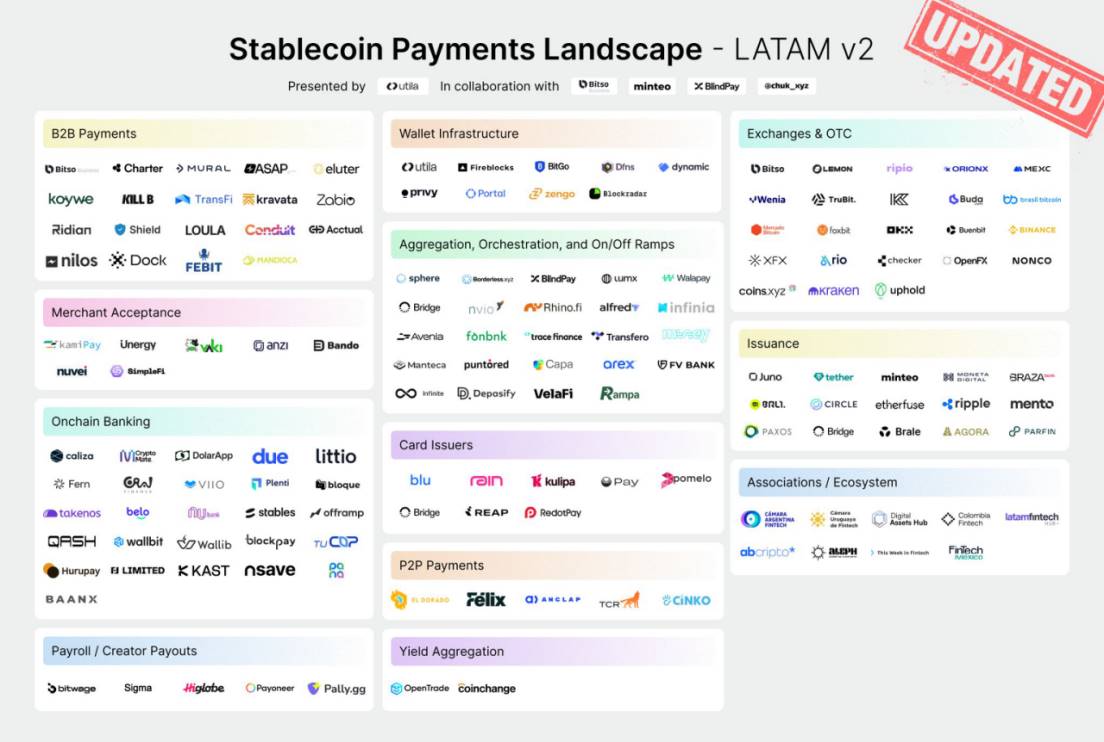
We have also briefly outlined the panoramic view of the Latin American crypto financial ecosystem as organized by Chuk Okpalugo, discovering from the perspective of stablecoin payments:
Most startups concentrated after 2021, typically consisting of teams of around 10 people, in the early seed round stage, serving local markets;
Basic services are presented in the form of APIs:
Currency acceptance: Inflows and outflows between local Latin American currencies and stablecoins;
Global payments: Whether through fiat pathways (SWIFT + correspondent banks) or stablecoin pathways (OTC + VA account capabilities).
On top of this basic service capability, different scenarios are being constructed, such as B2B enterprise payments, P2P inflow and outflow networks, C2C remittances, stablecoin acceptance, and bank-like services.
The evolutionary trajectory of native projects: Early stages will primarily focus on local channels, quickly entering the mid-stage, gradually covering several major economies in Latin America (such as licensed VASPs in various locations, then connecting local networks like PIX, etc.); later stages will form channels that connect the continent (such as Conduit's Latin America-Africa channel), ultimately establishing a global stablecoin settlement network based on local Latin America (like the Bridge network).
Traditional enterprises will embed cryptocurrencies/stablecoins into their existing ecological scenarios, which may yield immediate effects, but still depend on clear regulations and market education. For example, local "super apps" in Latin America like Nubank, Mercado Pago, PicPay, and RappiPay have emulated Revolut and PayPal by directly embedding crypto assets into their banking stacks, serving hundreds of millions of users.
It is still very early, as shown in the Dune report:
Exchanges remain the core financial infrastructure. They support the entire retail adoption, institutional activity, and cross-border value transfer in Latin America: annual traffic surged ninefold from 2021 to 2024, reaching $27 billion. Ethereum is used for large settlements, Tron for low-cost USDT payments, and Solana and Polygon support the expanding retail traffic.
Stablecoins are the backbone of the on-chain economy in Latin America. Payment applications and stablecoins are regional products—market fit points, with a lack of trust in the traditional financial system and economic crises driving demand. By July 2025, USDT and USDC accounted for over 90% of the tracked exchange transaction volume. At the same time, local currency-pegged stablecoins are also on the rise: BRL stablecoin transaction volume increased by 660% year-on-year, and MXN stablecoin volume surged by 1,100 times, becoming new tools for domestic payments.
Payment applications are evolving into "crypto-native digital banks." Crypto has become the backend infrastructure, with strong demand for payments and savings. Platforms like Picnic, Exa, and BlindPay integrate stablecoin balances, savings, and real-world consumption into a single interface. Whether or not they have bank accounts, a growing number of young, mobile-first users are increasingly using crypto to meet their daily financial needs.
VI. Final Thoughts
The cryptocurrency ecosystem in Latin America is no longer a "novel phenomenon," but an irreversible force rewriting financial rules. Economic turmoil, regulatory vacuums, and innovative vitality resonate together, making this continent the most dramatic and experimental battlefield in the global crypto landscape. Argentina, Brazil, Colombia, and Mexico are the first to break through, each staging a real-life drama of "on-chain capital redistribution": old wealth is being repriced, and new opportunities are growing wildly.
Although regulation is the elephant in the room in Latin America, it is precisely because of this that opportunities abound. Local startups are rising to the occasion, targeting regional pain points such as financial inclusion, cross-border remittances, and inflation hedging, using stablecoins, DeFi, and on-chain credit products to directly embed "bank branches" into users' smartphones. As long as their phones are charged, the people of Latin America can bypass the layers of traditional finance to complete the full suite of actions for saving, borrowing, investing, and remitting.
Despite the many challenges ahead. Economic fluctuations, political instability, and currency devaluation act like ticking time bombs; the lack of crypto education further blocks large-scale adoption, as many still equate blockchain with "get-rich-quick" or "quick bankruptcy" roulette. Yet the future remains bright. Latin America has one of the youngest and most tech-savvy populations globally, with a startup ecosystem expanding at double-digit rates, making it a natural innovation greenhouse. If the regulatory framework evolves appropriately, this continent has every chance to leap over the "old version" of traditional finance and directly transition to the "latest version" of the crypto economy.
Brazil has proven: clear rules = institutional funds + compliant innovation; Argentina is in a honeymoon window with the new government embracing the industry, and timely legislation could solidify its regional leadership; once regulation clarifies in Mexico, the massive remittance demand and fintech accumulation will instantly amplify on-chain traffic; Colombia, on the other hand, must first overcome both technological and regulatory hurdles to realize its potential.
Latin America is by no means a simple "emerging market," but a volcano waiting to erupt. The growth space is vast, but those who wish to ride the wave must be quick, agile, and prepared to navigate uncertainty: crossing regulatory barriers, educating the public, and winning users with innovative solutions that address regional pain points are essential to staying at the table in this on-chain capital redistribution, rather than becoming a footnote.
免责声明:本文章仅代表作者个人观点,不代表本平台的立场和观点。本文章仅供信息分享,不构成对任何人的任何投资建议。用户与作者之间的任何争议,与本平台无关。如网页中刊载的文章或图片涉及侵权,请提供相关的权利证明和身份证明发送邮件到support@aicoin.com,本平台相关工作人员将会进行核查。




